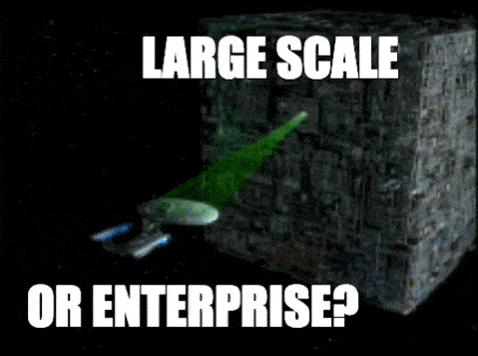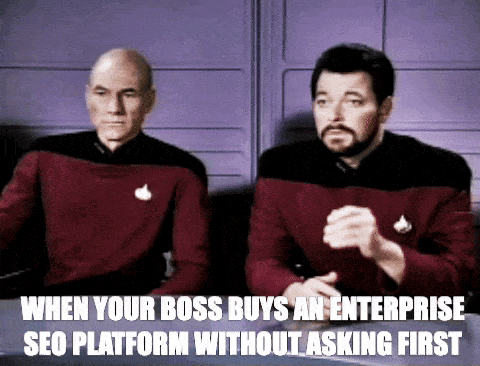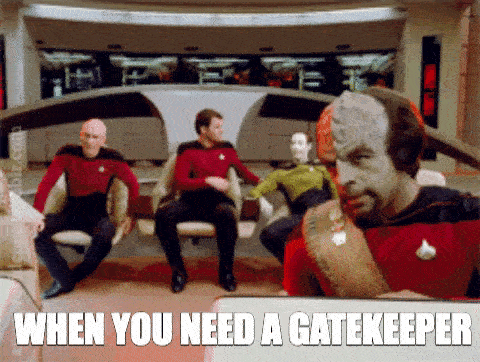What is Large-Scale & Enterprise SEO?

Large-scale SEO is the practice of increasing the quantity and quality of traffic to sites with a large amount of content through organic search engine results. While large-scale SEO is often synonymous with enterprise SEO, enterprise SEO is more specifically the practice of SEO in a large or established company. The size of these companies and the fact that they’ve been in business for a significant amount of time leads to a much larger corpus of information. In some consumer-facing and e-commerce contexts, large-scale SEO is less frequently associated with enterprises due to large catalogs of products in B2C, but for B2B the large-scale and enterprise SEO really is more often than not the same thing.
How is Large-Scale & Enterprise SEO Different?
In a small or medium-scale site, much of the time it makes sense to fix technical issues on a page by page basis. In a large-scale site, the number of technical issues likely to be found is much larger and tackling them one by one is likely to be too time-consuming and less effective. When it comes to solving technical SEO issues you’ll need to look for solutions that affect a large number of pages at once or that are at least somewhat scalable.
 Since you’ll be looking for solutions that affect a large number of pages, you’ll be much more dependent on your web development team or the capabilities of your content management system (CMS). For example, if page speed is an issue across your site, it’s not enough to optimize the images on a few pages, you’ll need to look at the javascript, CSS and other site-wide scripts that are having an effect on your page load time. Your web developer will be key in determining which changes are possible, will have the biggest impact and will be the one getting changes implemented.
Since you’ll be looking for solutions that affect a large number of pages, you’ll be much more dependent on your web development team or the capabilities of your content management system (CMS). For example, if page speed is an issue across your site, it’s not enough to optimize the images on a few pages, you’ll need to look at the javascript, CSS and other site-wide scripts that are having an effect on your page load time. Your web developer will be key in determining which changes are possible, will have the biggest impact and will be the one getting changes implemented.
The capabilities of your CMS will also be extremely important. While you still might want to manually optimize select, high-priority page’s Titles, meta descriptions, and other metadata you’ll also want to modify the CMS rules for automatic creation of metadata. If your CMS doesn’t have the capability to modify the automatically created metadata then you’ll need to work with your developers to make meta changes at scale.
Another factor that is particular to working with enterprises is the inherent bureaucracy of large organizations. You are much more likely to deal with a large number of stakeholders in the enterprise and getting approval for everything from keywords to content will be much more complicated. You’ll also find that getting SEO optimization tasks accomplished will involve cross-department teams. Imagery and other creative might come from one department while another department is in charge of written copy. The web development team is likely to reside outside the marketing team and there is a chance that the developers will be separate from the IT team that owns the web hosting.
With a large-scale site, there is also the likelihood that there will be multiple product marketing teams or business units (BUs) that have a vested interest in how to approach SEO. There is likely to be competition for the limited SEO resources available and prioritization across product marketing or BU teams can be difficult.
Tools for Large-Scale & Enterprise SEO
 Another consideration with large-scale SEO is the different tools that specialize in large-scale SEO. It is common for marketing departments with a large-scale site to invest in an SEO platform like Brightedge or Conductor. There is even a well respected and recently updated Enterprise SEO Platform Guide that will help you identify if you need an enterprise platform, and if so, which vendor provides the right solution for you. I would absolutely recommend downloading this guide.
Another consideration with large-scale SEO is the different tools that specialize in large-scale SEO. It is common for marketing departments with a large-scale site to invest in an SEO platform like Brightedge or Conductor. There is even a well respected and recently updated Enterprise SEO Platform Guide that will help you identify if you need an enterprise platform, and if so, which vendor provides the right solution for you. I would absolutely recommend downloading this guide.
However, I’ve found that many companies don’t actually need the most robust of these platforms. I worked on SEO for a company in the Fortune 20 with a very large site serving a global audience. While this company had a significant in-house & agency SEO team, they still didn’t fully utilize the enterprise SEO platform that consumed a significant amount of the annual SEO budget. Before you choose to buy an enterprise SEO platform, I’d suggest closely evaluating what you need from an SEO platform. If you have a large and widely distributed team, then the features of an enterprise platform might be worth the cost, but there’s a good chance a lighter weight platform like Moz, SEMRush or Ahrefs, will be more than sufficient to meet your needs.
3 Large-Scale & Enterprise SEO Strategies
 Once you understand the scale of your SEO challenge it can quickly become overwhelming to figure out how to tackle the large number of SEO issues that are likely to be hiding on your site. There are a few large-scale SEO strategies that I’ve found to be successful and these are a good starting point for any enterprise SEO strategy.
Once you understand the scale of your SEO challenge it can quickly become overwhelming to figure out how to tackle the large number of SEO issues that are likely to be hiding on your site. There are a few large-scale SEO strategies that I’ve found to be successful and these are a good starting point for any enterprise SEO strategy.
1. Scalable Solutions
As I mentioned above, fixing issues one by one on a large site can both be very time consuming and have a much lower impact than trying to find a scalable solution. When looking at technical issues, commonality of the problem across a large number of pages should start to become a major factor when prioritizing which problems to tackle first. Look for problems that occur across a single or a small number of folders in the URL structure. Large scale sites often use faceted navigation which can lead to duplicative content across a site and simple change of URL parameters in Google Search Console can remove unnecessary content from Google’s index. Even A/B testing can be done at scale by finding and testing common elements across multiple pages to more quickly reach statistical significance and ensure a major impact if the testing is successful. Again, working with developers will be key to identifying scalable solutions and working within the structure of your CMS will help you find solutions that can affect a large number of pages.
2. Treat each BUs & Product Teams as a Client and have a Gatekeeper
 I’ve found that one of the best ways to work with multiple BUs or product marketing teams is to treat them each as a separate client. This is particularly true when conducting keyword research and developing a content strategy. The different teams don’t necessarily care about the keyword their colleagues are prioritizing for SEO rankings. While this strategy is effective in making sure every team feels that their priorities are being met, this will only really be effective if you have a central authority that is ensuring that resources are being devoted to the BUs or products that are the highest priority. This gatekeeper is also really important to ensure that feedback provided by the teams is consolidated and that content created by the teams gets done on time.
I’ve found that one of the best ways to work with multiple BUs or product marketing teams is to treat them each as a separate client. This is particularly true when conducting keyword research and developing a content strategy. The different teams don’t necessarily care about the keyword their colleagues are prioritizing for SEO rankings. While this strategy is effective in making sure every team feels that their priorities are being met, this will only really be effective if you have a central authority that is ensuring that resources are being devoted to the BUs or products that are the highest priority. This gatekeeper is also really important to ensure that feedback provided by the teams is consolidated and that content created by the teams gets done on time.
3. Create Pillar Content
Given the large corpus of content on the typical large-scale site, there is likely to be content related to a single topic spread throughout the site. For example, your large-scale site probably has blog posts, whitepapers, videos and guides on a single topic. A pillar page would incorporate portions of each of these content types and link out to each of the individual content items. This would create the ultimate resource for this topic from your company.
Creating pillar content on a topic that incorporates and links to relevant content on that topic can help in multiple ways. First, pillar pages can expose disparate content from around your site to prospects browsing your site. There is also evidence that Google’s algorithms favor well-organized sites and the pillar pages put a layer of topical organization on your content that doesn’t currently exist on the site. Pillar pages are also a great way to target keywords with higher search volume and prospects earlier in the buyer’s journey, while not ignoring your long-tail keywords. Presenting content further down the buyer’s journey on pillar pages also makes it more likely that prospects will stay on your site as they continue to do research.
